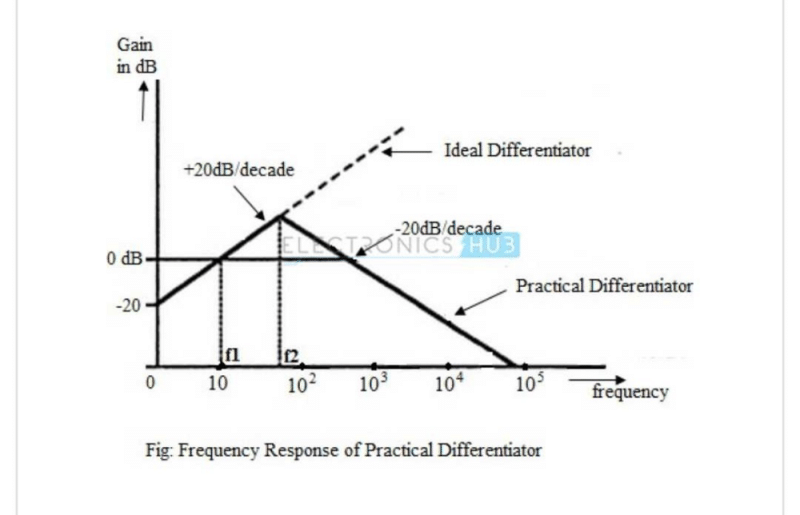Electrical Engineering (EE) Exam > Electrical Engineering (EE) Questions > The slope of the frequency response of a diff...
Start Learning for Free
The slope of the frequency response of a differentiator is
- a)Linear with negative slope
- b)Linear with positive slope
- c)Exponential increase
- d)Exponential decrease
Correct answer is option 'B'. Can you explain this answer?
Verified Answer
The slope of the frequency response of a differentiator isa)Linear wit...
The slope is linear with a positive slope.
Most Upvoted Answer
The slope of the frequency response of a differentiator isa)Linear wit...
Frequency Response of a Differentiator
A differentiator is a circuit that produces an output voltage proportional to the rate of change of the input voltage with respect to time. The frequency response of a differentiator is the plot of the output voltage against the frequency of the input signal.
Linear with Positive Slope
The slope of the frequency response of a differentiator is linear with a positive slope. This means that as the frequency of the input signal increases, the output voltage of the differentiator also increases. The slope of the frequency response is directly proportional to the gain of the differentiator.
Explanation
The frequency response of a differentiator can be derived from the transfer function of the circuit. The transfer function is the ratio of the output voltage to the input voltage in the frequency domain. For a differentiator circuit, the transfer function is given by:
H(jω) = jωRC
where j is the imaginary unit, ω is the angular frequency, R is the resistance, and C is the capacitance of the circuit.
The magnitude of the transfer function is given by:
|H(jω)| = ωRC
This shows that the magnitude of the transfer function is directly proportional to the frequency of the input signal. Therefore, the slope of the frequency response is linear with a positive slope.
Conclusion
In conclusion, the slope of the frequency response of a differentiator is linear with a positive slope. This means that as the frequency of the input signal increases, the output voltage of the differentiator also increases. The slope of the frequency response is directly proportional to the gain of the differentiator.
A differentiator is a circuit that produces an output voltage proportional to the rate of change of the input voltage with respect to time. The frequency response of a differentiator is the plot of the output voltage against the frequency of the input signal.
Linear with Positive Slope
The slope of the frequency response of a differentiator is linear with a positive slope. This means that as the frequency of the input signal increases, the output voltage of the differentiator also increases. The slope of the frequency response is directly proportional to the gain of the differentiator.
Explanation
The frequency response of a differentiator can be derived from the transfer function of the circuit. The transfer function is the ratio of the output voltage to the input voltage in the frequency domain. For a differentiator circuit, the transfer function is given by:
H(jω) = jωRC
where j is the imaginary unit, ω is the angular frequency, R is the resistance, and C is the capacitance of the circuit.
The magnitude of the transfer function is given by:
|H(jω)| = ωRC
This shows that the magnitude of the transfer function is directly proportional to the frequency of the input signal. Therefore, the slope of the frequency response is linear with a positive slope.
Conclusion
In conclusion, the slope of the frequency response of a differentiator is linear with a positive slope. This means that as the frequency of the input signal increases, the output voltage of the differentiator also increases. The slope of the frequency response is directly proportional to the gain of the differentiator.
Free Test
FREE
| Start Free Test |
Community Answer
The slope of the frequency response of a differentiator isa)Linear wit...


|
Explore Courses for Electrical Engineering (EE) exam
|

|
Question Description
The slope of the frequency response of a differentiator isa)Linear with negative slopeb)Linear with positive slopec)Exponential increased)Exponential decreaseCorrect answer is option 'B'. Can you explain this answer? for Electrical Engineering (EE) 2025 is part of Electrical Engineering (EE) preparation. The Question and answers have been prepared according to the Electrical Engineering (EE) exam syllabus. Information about The slope of the frequency response of a differentiator isa)Linear with negative slopeb)Linear with positive slopec)Exponential increased)Exponential decreaseCorrect answer is option 'B'. Can you explain this answer? covers all topics & solutions for Electrical Engineering (EE) 2025 Exam. Find important definitions, questions, meanings, examples, exercises and tests below for The slope of the frequency response of a differentiator isa)Linear with negative slopeb)Linear with positive slopec)Exponential increased)Exponential decreaseCorrect answer is option 'B'. Can you explain this answer?.
The slope of the frequency response of a differentiator isa)Linear with negative slopeb)Linear with positive slopec)Exponential increased)Exponential decreaseCorrect answer is option 'B'. Can you explain this answer? for Electrical Engineering (EE) 2025 is part of Electrical Engineering (EE) preparation. The Question and answers have been prepared according to the Electrical Engineering (EE) exam syllabus. Information about The slope of the frequency response of a differentiator isa)Linear with negative slopeb)Linear with positive slopec)Exponential increased)Exponential decreaseCorrect answer is option 'B'. Can you explain this answer? covers all topics & solutions for Electrical Engineering (EE) 2025 Exam. Find important definitions, questions, meanings, examples, exercises and tests below for The slope of the frequency response of a differentiator isa)Linear with negative slopeb)Linear with positive slopec)Exponential increased)Exponential decreaseCorrect answer is option 'B'. Can you explain this answer?.
Solutions for The slope of the frequency response of a differentiator isa)Linear with negative slopeb)Linear with positive slopec)Exponential increased)Exponential decreaseCorrect answer is option 'B'. Can you explain this answer? in English & in Hindi are available as part of our courses for Electrical Engineering (EE).
Download more important topics, notes, lectures and mock test series for Electrical Engineering (EE) Exam by signing up for free.
Here you can find the meaning of The slope of the frequency response of a differentiator isa)Linear with negative slopeb)Linear with positive slopec)Exponential increased)Exponential decreaseCorrect answer is option 'B'. Can you explain this answer? defined & explained in the simplest way possible. Besides giving the explanation of
The slope of the frequency response of a differentiator isa)Linear with negative slopeb)Linear with positive slopec)Exponential increased)Exponential decreaseCorrect answer is option 'B'. Can you explain this answer?, a detailed solution for The slope of the frequency response of a differentiator isa)Linear with negative slopeb)Linear with positive slopec)Exponential increased)Exponential decreaseCorrect answer is option 'B'. Can you explain this answer? has been provided alongside types of The slope of the frequency response of a differentiator isa)Linear with negative slopeb)Linear with positive slopec)Exponential increased)Exponential decreaseCorrect answer is option 'B'. Can you explain this answer? theory, EduRev gives you an
ample number of questions to practice The slope of the frequency response of a differentiator isa)Linear with negative slopeb)Linear with positive slopec)Exponential increased)Exponential decreaseCorrect answer is option 'B'. Can you explain this answer? tests, examples and also practice Electrical Engineering (EE) tests.

|
Explore Courses for Electrical Engineering (EE) exam
|

|
Signup for Free!
Signup to see your scores go up within 7 days! Learn & Practice with 1000+ FREE Notes, Videos & Tests.


















